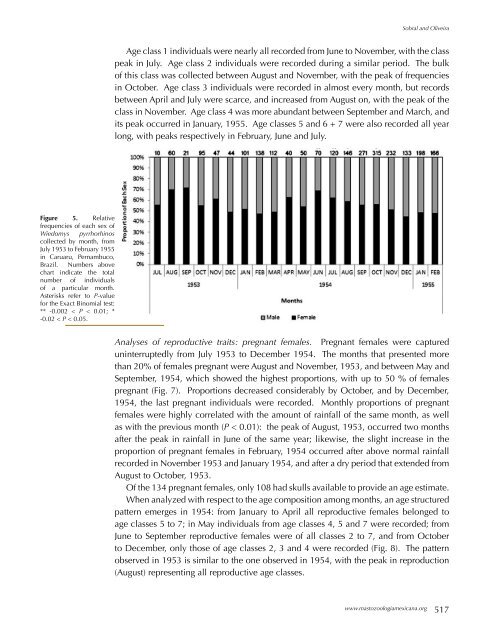therya-5_2
therya-5_2
therya-5_2
You also want an ePaper? Increase the reach of your titles
YUMPU automatically turns print PDFs into web optimized ePapers that Google loves.
Sobral and Oliveira<br />
Age class 1 individuals were nearly all recorded from June to November, with the class<br />
peak in July. Age class 2 individuals were recorded during a similar period. The bulk<br />
of this class was collected between August and November, with the peak of frequencies<br />
in October. Age class 3 individuals were recorded in almost every month, but records<br />
between April and July were scarce, and increased from August on, with the peak of the<br />
class in November. Age class 4 was more abundant between September and March, and<br />
its peak occurred in January, 1955. Age classes 5 and 6 + 7 were also recorded all year<br />
long, with peaks respectively in February, June and July.<br />
Figure 5. Relative<br />
frequencies of each sex of<br />
Wiedomys pyrrhorhinos<br />
collected by month, from<br />
July 1953 to February 1955<br />
in Caruaru, Pernambuco,<br />
Brazil. Numbers above<br />
chart indicate the total<br />
number of individuals<br />
of a particular month.<br />
Asterisks refer to P-value<br />
for the Exact Binomial test:<br />
** -0.002 < P < 0.01; *<br />
-0.02 < P < 0.05.<br />
Analyses of reproductive traits: pregnant females. Pregnant females were captured<br />
uninterruptedly from July 1953 to December 1954. The months that presented more<br />
than 20% of females pregnant were August and November, 1953, and between May and<br />
September, 1954, which showed the highest proportions, with up to 50 % of females<br />
pregnant (Fig. 7). Proportions decreased considerably by October, and by December,<br />
1954, the last pregnant individuals were recorded. Monthly proportions of pregnant<br />
females were highly correlated with the amount of rainfall of the same month, as well<br />
as with the previous month (P < 0.01): the peak of August, 1953, occurred two months<br />
after the peak in rainfall in June of the same year; likewise, the slight increase in the<br />
proportion of pregnant females in February, 1954 occurred after above normal rainfall<br />
recorded in November 1953 and January 1954, and after a dry period that extended from<br />
August to October, 1953.<br />
Of the 134 pregnant females, only 108 had skulls available to provide an age estimate.<br />
When analyzed with respect to the age composition among months, an age structured<br />
pattern emerges in 1954: from January to April all reproductive females belonged to<br />
age classes 5 to 7; in May individuals from age classes 4, 5 and 7 were recorded; from<br />
June to September reproductive females were of all classes 2 to 7, and from October<br />
to December, only those of age classes 2, 3 and 4 were recorded (Fig. 8). The pattern<br />
observed in 1953 is similar to the one observed in 1954, with the peak in reproduction<br />
(August) representing all reproductive age classes.<br />
www.mastozoologiamexicana.org<br />
517



